A Comprehensive Analysis of Unemployment in Australia (2013-2018)
VerifiedAdded on 2021/06/14
|15
|3557
|37
Essay
AI Summary
This essay provides a comprehensive analysis of unemployment in Australia from 2013 to 2018, examining various facets of the labor market. It begins by defining unemployment and its associated problems, emphasizing its impact on both the current and future generations. The essay then delves into the different types of unemployment, including cyclical, structural, and frictional unemployment, providing context within the Australian economic landscape. It presents statistical data from the Australian Bureau of Statistics, highlighting unemployment rates, labor force participation, and employment trends over the five-year period. The analysis covers key periods, such as 2013, 2014, 2016, 2017, and 2018, showcasing fluctuations in the labor market and the impact of factors like technological changes and global economic conditions. The essay also discusses the issues of underemployment, youth unemployment, and the challenges faced by immigrants in the Australian labor market. It concludes by emphasizing the long-term consequences of unemployment on economic and social well-being, offering a detailed overview of the subject matter.
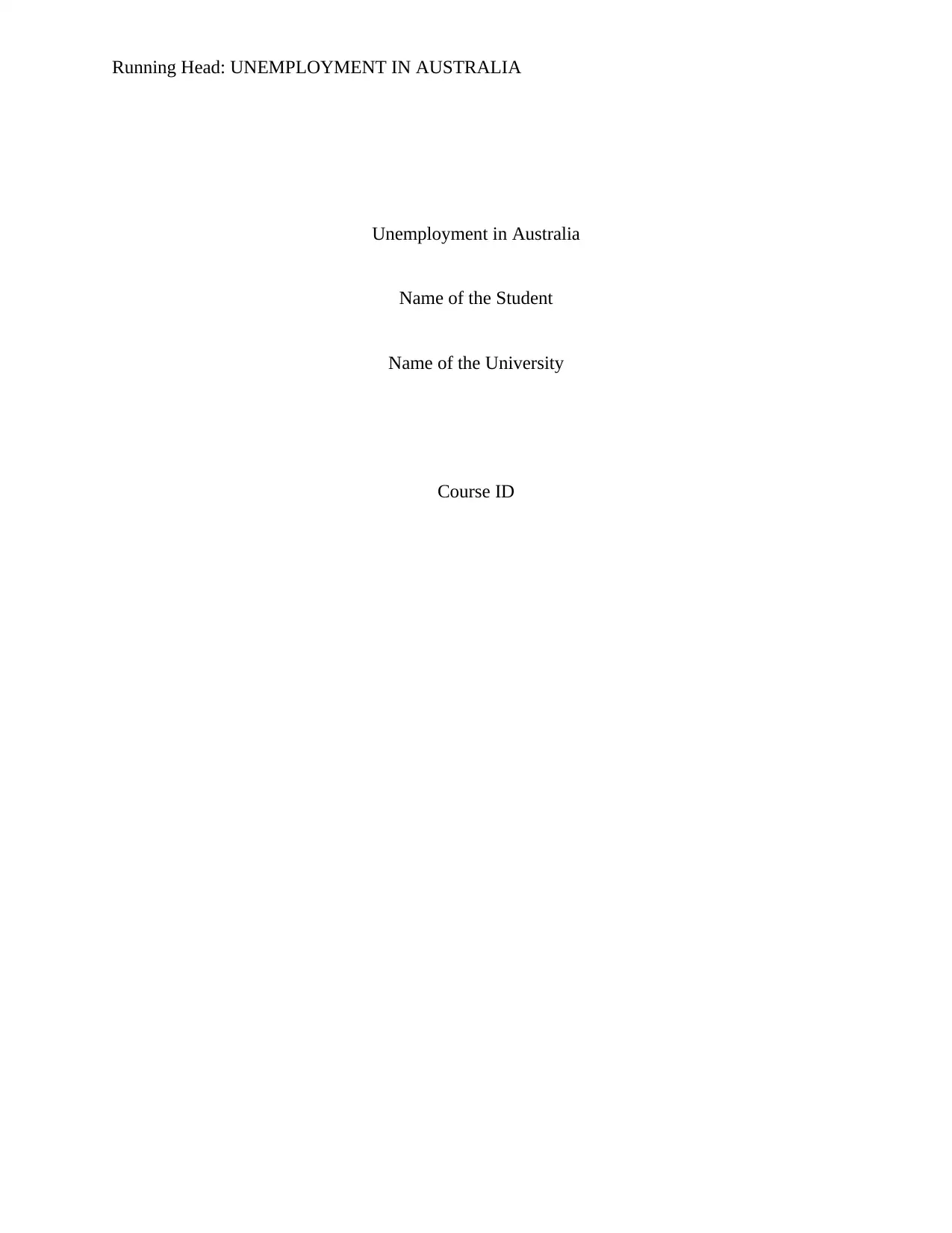
Running Head: UNEMPLOYMENT IN AUSTRALIA
Unemployment in Australia
Name of the Student
Name of the University
Course ID
Unemployment in Australia
Name of the Student
Name of the University
Course ID
Paraphrase This Document
Need a fresh take? Get an instant paraphrase of this document with our AI Paraphraser
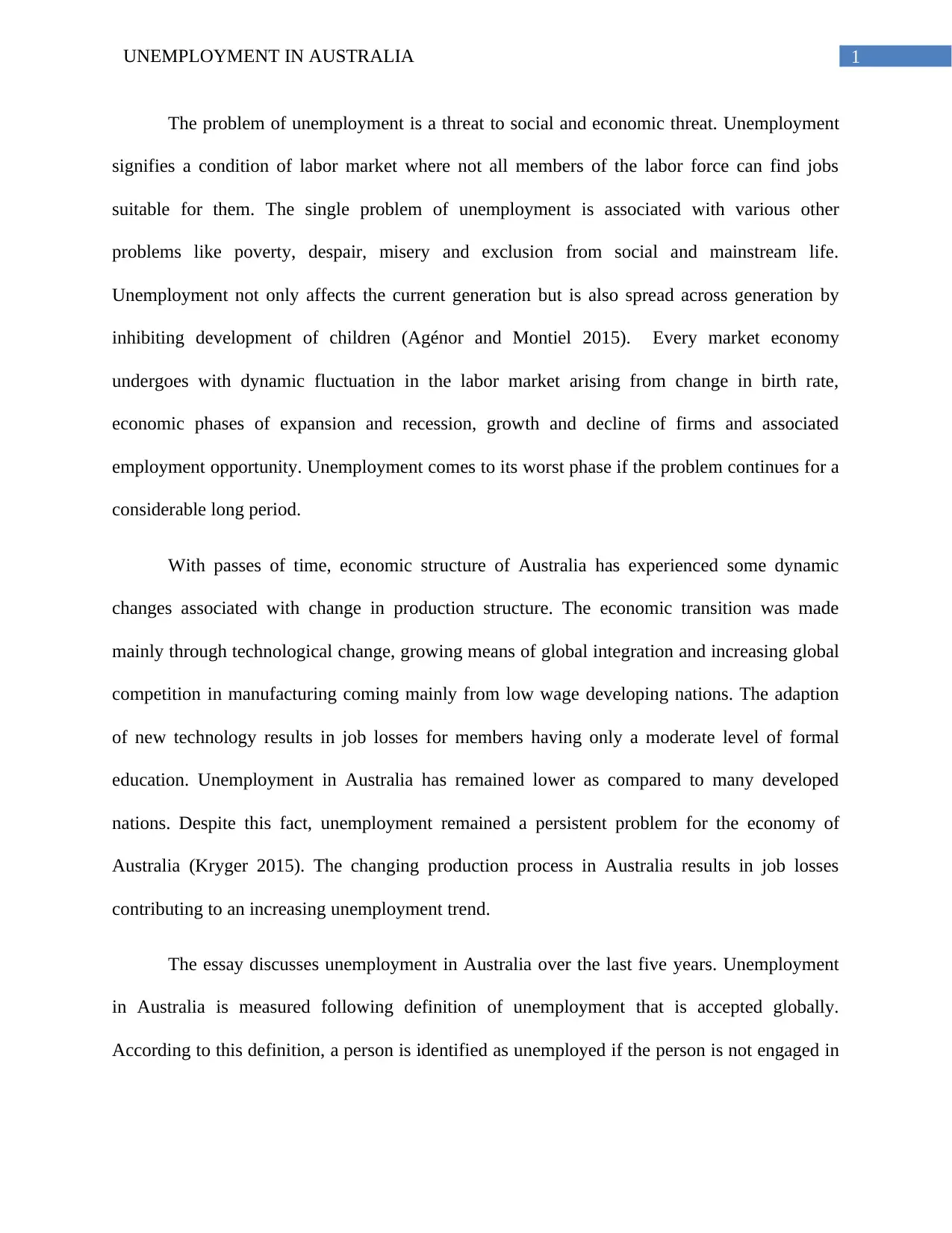
1UNEMPLOYMENT IN AUSTRALIA
The problem of unemployment is a threat to social and economic threat. Unemployment
signifies a condition of labor market where not all members of the labor force can find jobs
suitable for them. The single problem of unemployment is associated with various other
problems like poverty, despair, misery and exclusion from social and mainstream life.
Unemployment not only affects the current generation but is also spread across generation by
inhibiting development of children (Agénor and Montiel 2015). Every market economy
undergoes with dynamic fluctuation in the labor market arising from change in birth rate,
economic phases of expansion and recession, growth and decline of firms and associated
employment opportunity. Unemployment comes to its worst phase if the problem continues for a
considerable long period.
With passes of time, economic structure of Australia has experienced some dynamic
changes associated with change in production structure. The economic transition was made
mainly through technological change, growing means of global integration and increasing global
competition in manufacturing coming mainly from low wage developing nations. The adaption
of new technology results in job losses for members having only a moderate level of formal
education. Unemployment in Australia has remained lower as compared to many developed
nations. Despite this fact, unemployment remained a persistent problem for the economy of
Australia (Kryger 2015). The changing production process in Australia results in job losses
contributing to an increasing unemployment trend.
The essay discusses unemployment in Australia over the last five years. Unemployment
in Australia is measured following definition of unemployment that is accepted globally.
According to this definition, a person is identified as unemployed if the person is not engaged in
The problem of unemployment is a threat to social and economic threat. Unemployment
signifies a condition of labor market where not all members of the labor force can find jobs
suitable for them. The single problem of unemployment is associated with various other
problems like poverty, despair, misery and exclusion from social and mainstream life.
Unemployment not only affects the current generation but is also spread across generation by
inhibiting development of children (Agénor and Montiel 2015). Every market economy
undergoes with dynamic fluctuation in the labor market arising from change in birth rate,
economic phases of expansion and recession, growth and decline of firms and associated
employment opportunity. Unemployment comes to its worst phase if the problem continues for a
considerable long period.
With passes of time, economic structure of Australia has experienced some dynamic
changes associated with change in production structure. The economic transition was made
mainly through technological change, growing means of global integration and increasing global
competition in manufacturing coming mainly from low wage developing nations. The adaption
of new technology results in job losses for members having only a moderate level of formal
education. Unemployment in Australia has remained lower as compared to many developed
nations. Despite this fact, unemployment remained a persistent problem for the economy of
Australia (Kryger 2015). The changing production process in Australia results in job losses
contributing to an increasing unemployment trend.
The essay discusses unemployment in Australia over the last five years. Unemployment
in Australia is measured following definition of unemployment that is accepted globally.
According to this definition, a person is identified as unemployed if the person is not engaged in
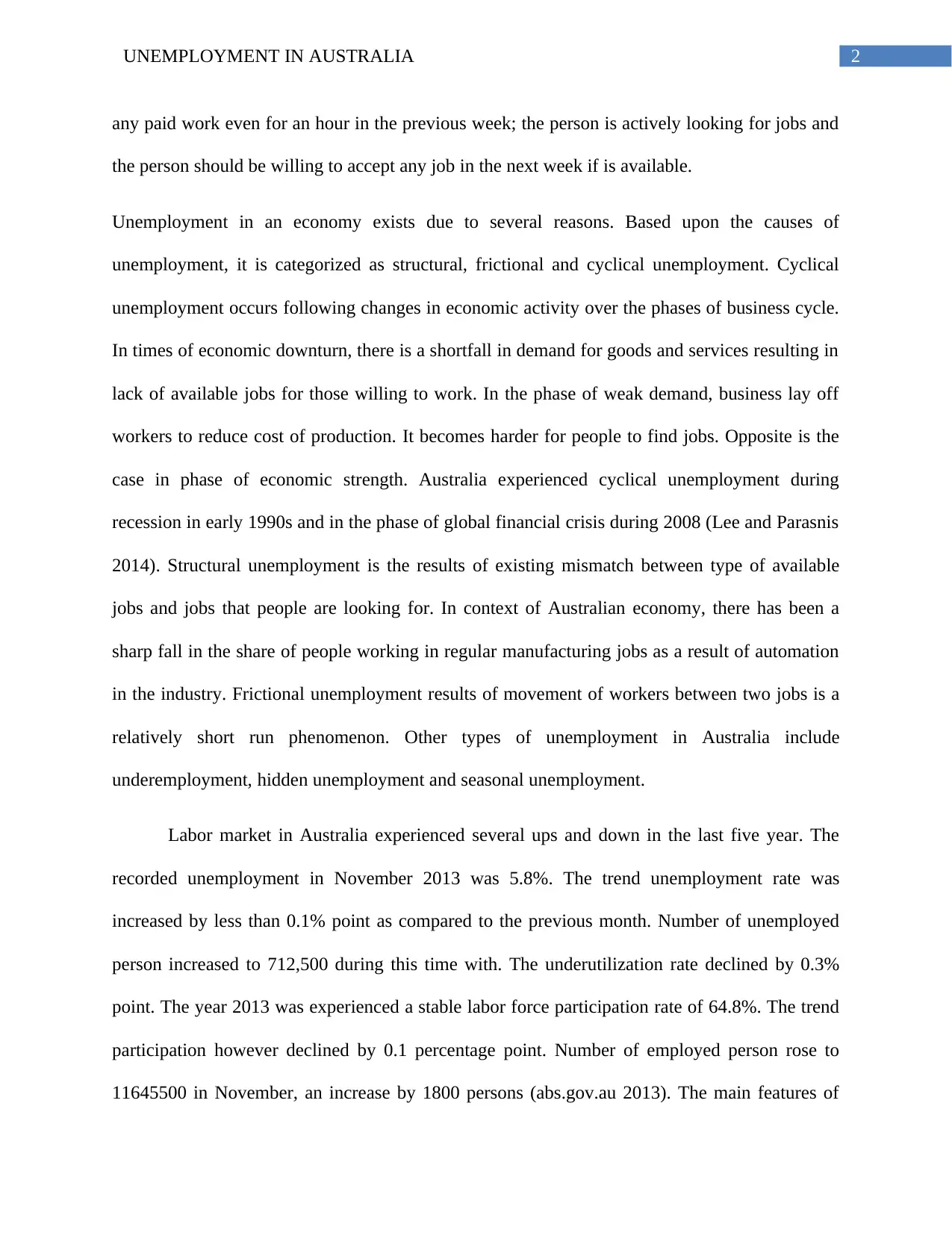
2UNEMPLOYMENT IN AUSTRALIA
any paid work even for an hour in the previous week; the person is actively looking for jobs and
the person should be willing to accept any job in the next week if is available.
Unemployment in an economy exists due to several reasons. Based upon the causes of
unemployment, it is categorized as structural, frictional and cyclical unemployment. Cyclical
unemployment occurs following changes in economic activity over the phases of business cycle.
In times of economic downturn, there is a shortfall in demand for goods and services resulting in
lack of available jobs for those willing to work. In the phase of weak demand, business lay off
workers to reduce cost of production. It becomes harder for people to find jobs. Opposite is the
case in phase of economic strength. Australia experienced cyclical unemployment during
recession in early 1990s and in the phase of global financial crisis during 2008 (Lee and Parasnis
2014). Structural unemployment is the results of existing mismatch between type of available
jobs and jobs that people are looking for. In context of Australian economy, there has been a
sharp fall in the share of people working in regular manufacturing jobs as a result of automation
in the industry. Frictional unemployment results of movement of workers between two jobs is a
relatively short run phenomenon. Other types of unemployment in Australia include
underemployment, hidden unemployment and seasonal unemployment.
Labor market in Australia experienced several ups and down in the last five year. The
recorded unemployment in November 2013 was 5.8%. The trend unemployment rate was
increased by less than 0.1% point as compared to the previous month. Number of unemployed
person increased to 712,500 during this time with. The underutilization rate declined by 0.3%
point. The year 2013 was experienced a stable labor force participation rate of 64.8%. The trend
participation however declined by 0.1 percentage point. Number of employed person rose to
11645500 in November, an increase by 1800 persons (abs.gov.au 2013). The main features of
any paid work even for an hour in the previous week; the person is actively looking for jobs and
the person should be willing to accept any job in the next week if is available.
Unemployment in an economy exists due to several reasons. Based upon the causes of
unemployment, it is categorized as structural, frictional and cyclical unemployment. Cyclical
unemployment occurs following changes in economic activity over the phases of business cycle.
In times of economic downturn, there is a shortfall in demand for goods and services resulting in
lack of available jobs for those willing to work. In the phase of weak demand, business lay off
workers to reduce cost of production. It becomes harder for people to find jobs. Opposite is the
case in phase of economic strength. Australia experienced cyclical unemployment during
recession in early 1990s and in the phase of global financial crisis during 2008 (Lee and Parasnis
2014). Structural unemployment is the results of existing mismatch between type of available
jobs and jobs that people are looking for. In context of Australian economy, there has been a
sharp fall in the share of people working in regular manufacturing jobs as a result of automation
in the industry. Frictional unemployment results of movement of workers between two jobs is a
relatively short run phenomenon. Other types of unemployment in Australia include
underemployment, hidden unemployment and seasonal unemployment.
Labor market in Australia experienced several ups and down in the last five year. The
recorded unemployment in November 2013 was 5.8%. The trend unemployment rate was
increased by less than 0.1% point as compared to the previous month. Number of unemployed
person increased to 712,500 during this time with. The underutilization rate declined by 0.3%
point. The year 2013 was experienced a stable labor force participation rate of 64.8%. The trend
participation however declined by 0.1 percentage point. Number of employed person rose to
11645500 in November, an increase by 1800 persons (abs.gov.au 2013). The main features of
⊘ This is a preview!⊘
Do you want full access?
Subscribe today to unlock all pages.

Trusted by 1+ million students worldwide
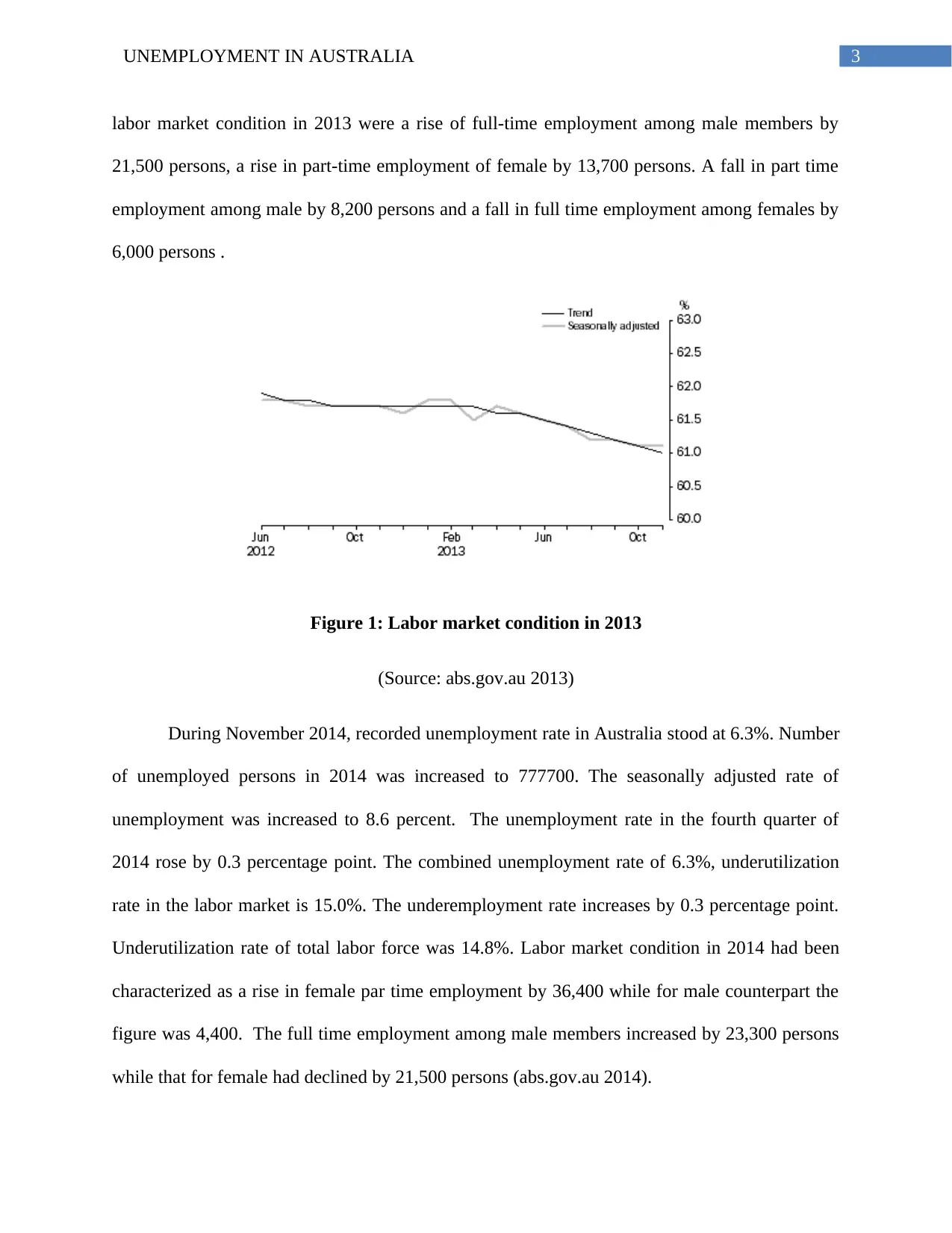
3UNEMPLOYMENT IN AUSTRALIA
labor market condition in 2013 were a rise of full-time employment among male members by
21,500 persons, a rise in part-time employment of female by 13,700 persons. A fall in part time
employment among male by 8,200 persons and a fall in full time employment among females by
6,000 persons .
Figure 1: Labor market condition in 2013
(Source: abs.gov.au 2013)
During November 2014, recorded unemployment rate in Australia stood at 6.3%. Number
of unemployed persons in 2014 was increased to 777700. The seasonally adjusted rate of
unemployment was increased to 8.6 percent. The unemployment rate in the fourth quarter of
2014 rose by 0.3 percentage point. The combined unemployment rate of 6.3%, underutilization
rate in the labor market is 15.0%. The underemployment rate increases by 0.3 percentage point.
Underutilization rate of total labor force was 14.8%. Labor market condition in 2014 had been
characterized as a rise in female par time employment by 36,400 while for male counterpart the
figure was 4,400. The full time employment among male members increased by 23,300 persons
while that for female had declined by 21,500 persons (abs.gov.au 2014).
labor market condition in 2013 were a rise of full-time employment among male members by
21,500 persons, a rise in part-time employment of female by 13,700 persons. A fall in part time
employment among male by 8,200 persons and a fall in full time employment among females by
6,000 persons .
Figure 1: Labor market condition in 2013
(Source: abs.gov.au 2013)
During November 2014, recorded unemployment rate in Australia stood at 6.3%. Number
of unemployed persons in 2014 was increased to 777700. The seasonally adjusted rate of
unemployment was increased to 8.6 percent. The unemployment rate in the fourth quarter of
2014 rose by 0.3 percentage point. The combined unemployment rate of 6.3%, underutilization
rate in the labor market is 15.0%. The underemployment rate increases by 0.3 percentage point.
Underutilization rate of total labor force was 14.8%. Labor market condition in 2014 had been
characterized as a rise in female par time employment by 36,400 while for male counterpart the
figure was 4,400. The full time employment among male members increased by 23,300 persons
while that for female had declined by 21,500 persons (abs.gov.au 2014).
Paraphrase This Document
Need a fresh take? Get an instant paraphrase of this document with our AI Paraphraser
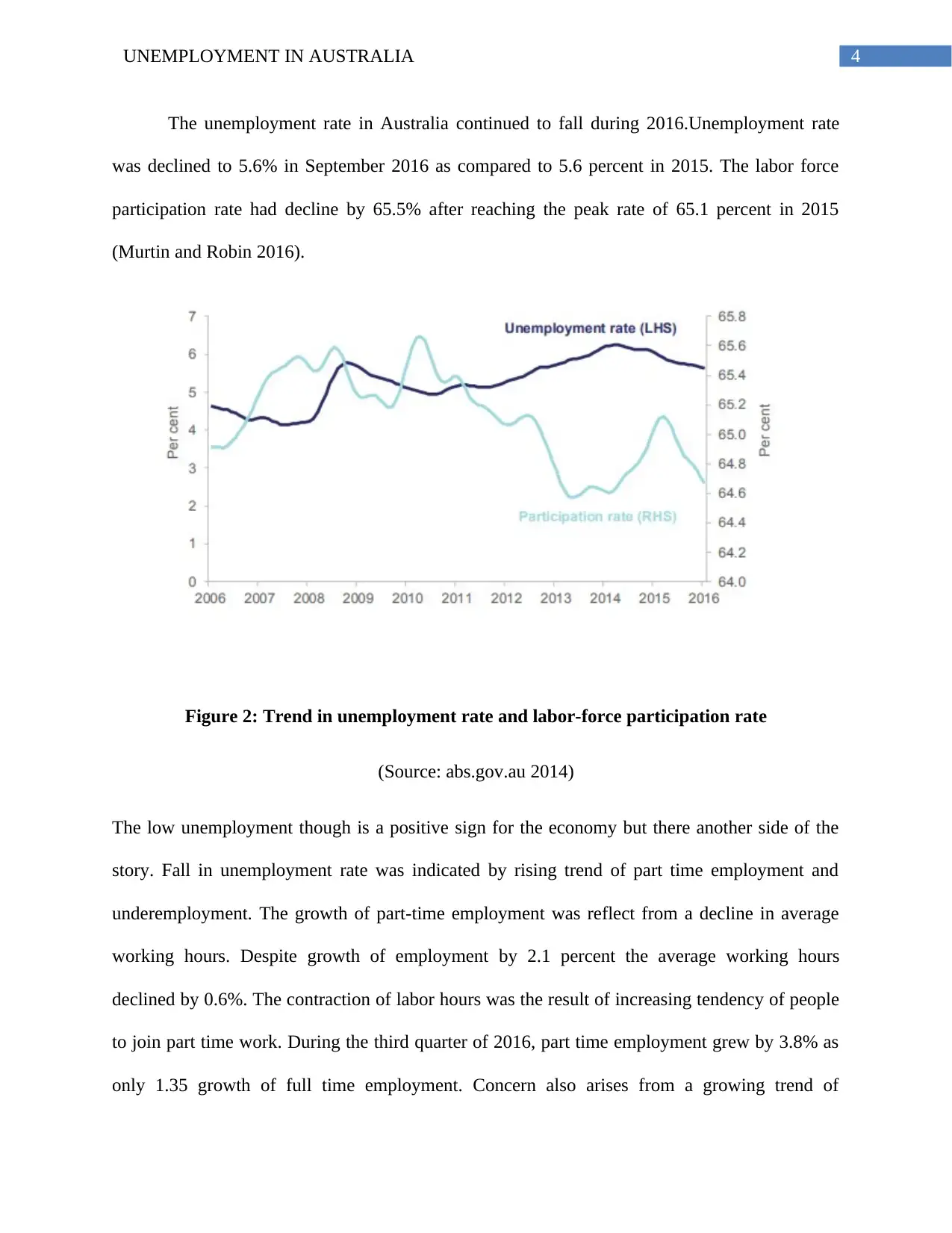
4UNEMPLOYMENT IN AUSTRALIA
The unemployment rate in Australia continued to fall during 2016.Unemployment rate
was declined to 5.6% in September 2016 as compared to 5.6 percent in 2015. The labor force
participation rate had decline by 65.5% after reaching the peak rate of 65.1 percent in 2015
(Murtin and Robin 2016).
Figure 2: Trend in unemployment rate and labor-force participation rate
(Source: abs.gov.au 2014)
The low unemployment though is a positive sign for the economy but there another side of the
story. Fall in unemployment rate was indicated by rising trend of part time employment and
underemployment. The growth of part-time employment was reflect from a decline in average
working hours. Despite growth of employment by 2.1 percent the average working hours
declined by 0.6%. The contraction of labor hours was the result of increasing tendency of people
to join part time work. During the third quarter of 2016, part time employment grew by 3.8% as
only 1.35 growth of full time employment. Concern also arises from a growing trend of
The unemployment rate in Australia continued to fall during 2016.Unemployment rate
was declined to 5.6% in September 2016 as compared to 5.6 percent in 2015. The labor force
participation rate had decline by 65.5% after reaching the peak rate of 65.1 percent in 2015
(Murtin and Robin 2016).
Figure 2: Trend in unemployment rate and labor-force participation rate
(Source: abs.gov.au 2014)
The low unemployment though is a positive sign for the economy but there another side of the
story. Fall in unemployment rate was indicated by rising trend of part time employment and
underemployment. The growth of part-time employment was reflect from a decline in average
working hours. Despite growth of employment by 2.1 percent the average working hours
declined by 0.6%. The contraction of labor hours was the result of increasing tendency of people
to join part time work. During the third quarter of 2016, part time employment grew by 3.8% as
only 1.35 growth of full time employment. Concern also arises from a growing trend of
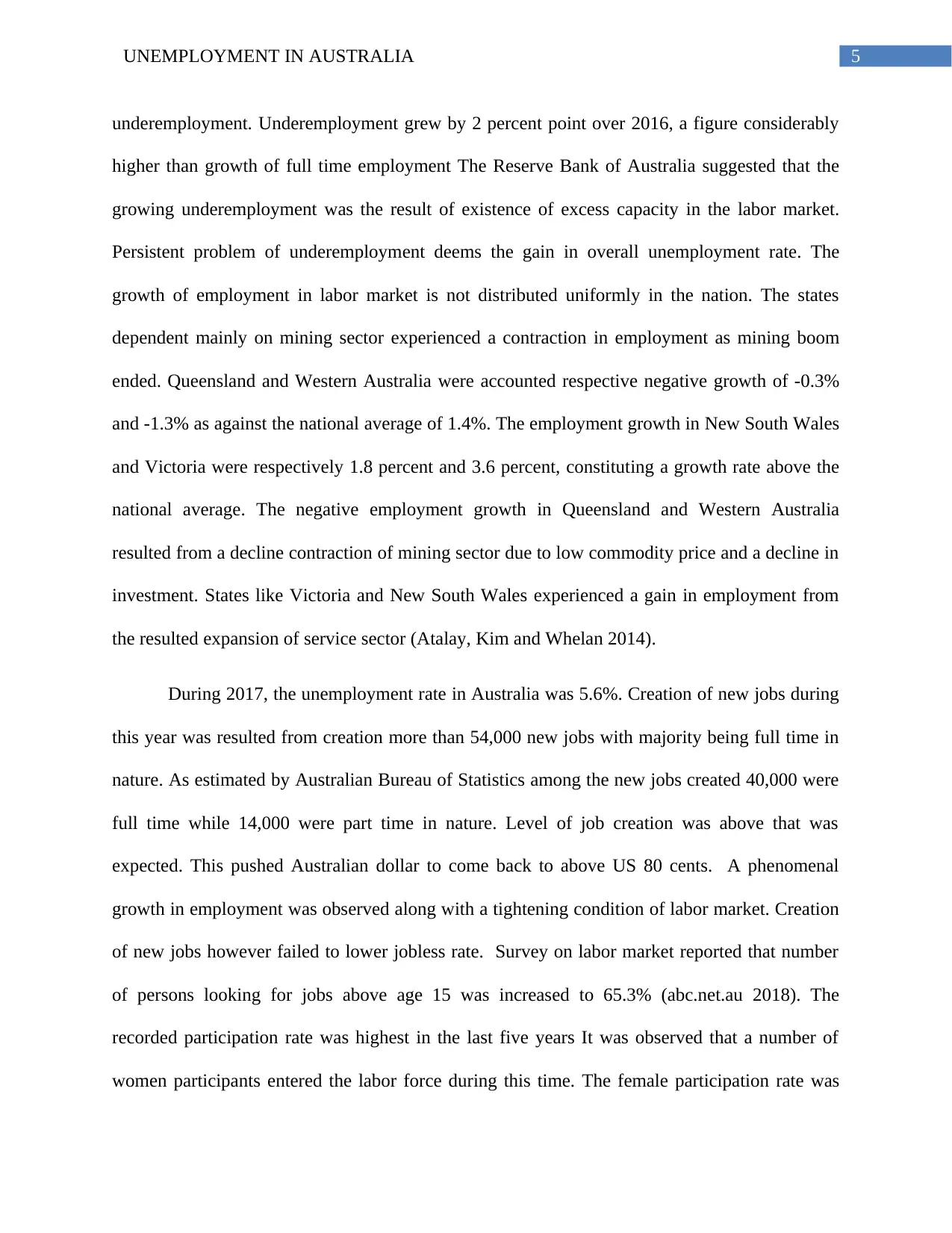
5UNEMPLOYMENT IN AUSTRALIA
underemployment. Underemployment grew by 2 percent point over 2016, a figure considerably
higher than growth of full time employment The Reserve Bank of Australia suggested that the
growing underemployment was the result of existence of excess capacity in the labor market.
Persistent problem of underemployment deems the gain in overall unemployment rate. The
growth of employment in labor market is not distributed uniformly in the nation. The states
dependent mainly on mining sector experienced a contraction in employment as mining boom
ended. Queensland and Western Australia were accounted respective negative growth of -0.3%
and -1.3% as against the national average of 1.4%. The employment growth in New South Wales
and Victoria were respectively 1.8 percent and 3.6 percent, constituting a growth rate above the
national average. The negative employment growth in Queensland and Western Australia
resulted from a decline contraction of mining sector due to low commodity price and a decline in
investment. States like Victoria and New South Wales experienced a gain in employment from
the resulted expansion of service sector (Atalay, Kim and Whelan 2014).
During 2017, the unemployment rate in Australia was 5.6%. Creation of new jobs during
this year was resulted from creation more than 54,000 new jobs with majority being full time in
nature. As estimated by Australian Bureau of Statistics among the new jobs created 40,000 were
full time while 14,000 were part time in nature. Level of job creation was above that was
expected. This pushed Australian dollar to come back to above US 80 cents. A phenomenal
growth in employment was observed along with a tightening condition of labor market. Creation
of new jobs however failed to lower jobless rate. Survey on labor market reported that number
of persons looking for jobs above age 15 was increased to 65.3% (abc.net.au 2018). The
recorded participation rate was highest in the last five years It was observed that a number of
women participants entered the labor force during this time. The female participation rate was
underemployment. Underemployment grew by 2 percent point over 2016, a figure considerably
higher than growth of full time employment The Reserve Bank of Australia suggested that the
growing underemployment was the result of existence of excess capacity in the labor market.
Persistent problem of underemployment deems the gain in overall unemployment rate. The
growth of employment in labor market is not distributed uniformly in the nation. The states
dependent mainly on mining sector experienced a contraction in employment as mining boom
ended. Queensland and Western Australia were accounted respective negative growth of -0.3%
and -1.3% as against the national average of 1.4%. The employment growth in New South Wales
and Victoria were respectively 1.8 percent and 3.6 percent, constituting a growth rate above the
national average. The negative employment growth in Queensland and Western Australia
resulted from a decline contraction of mining sector due to low commodity price and a decline in
investment. States like Victoria and New South Wales experienced a gain in employment from
the resulted expansion of service sector (Atalay, Kim and Whelan 2014).
During 2017, the unemployment rate in Australia was 5.6%. Creation of new jobs during
this year was resulted from creation more than 54,000 new jobs with majority being full time in
nature. As estimated by Australian Bureau of Statistics among the new jobs created 40,000 were
full time while 14,000 were part time in nature. Level of job creation was above that was
expected. This pushed Australian dollar to come back to above US 80 cents. A phenomenal
growth in employment was observed along with a tightening condition of labor market. Creation
of new jobs however failed to lower jobless rate. Survey on labor market reported that number
of persons looking for jobs above age 15 was increased to 65.3% (abc.net.au 2018). The
recorded participation rate was highest in the last five years It was observed that a number of
women participants entered the labor force during this time. The female participation rate was
⊘ This is a preview!⊘
Do you want full access?
Subscribe today to unlock all pages.

Trusted by 1+ million students worldwide
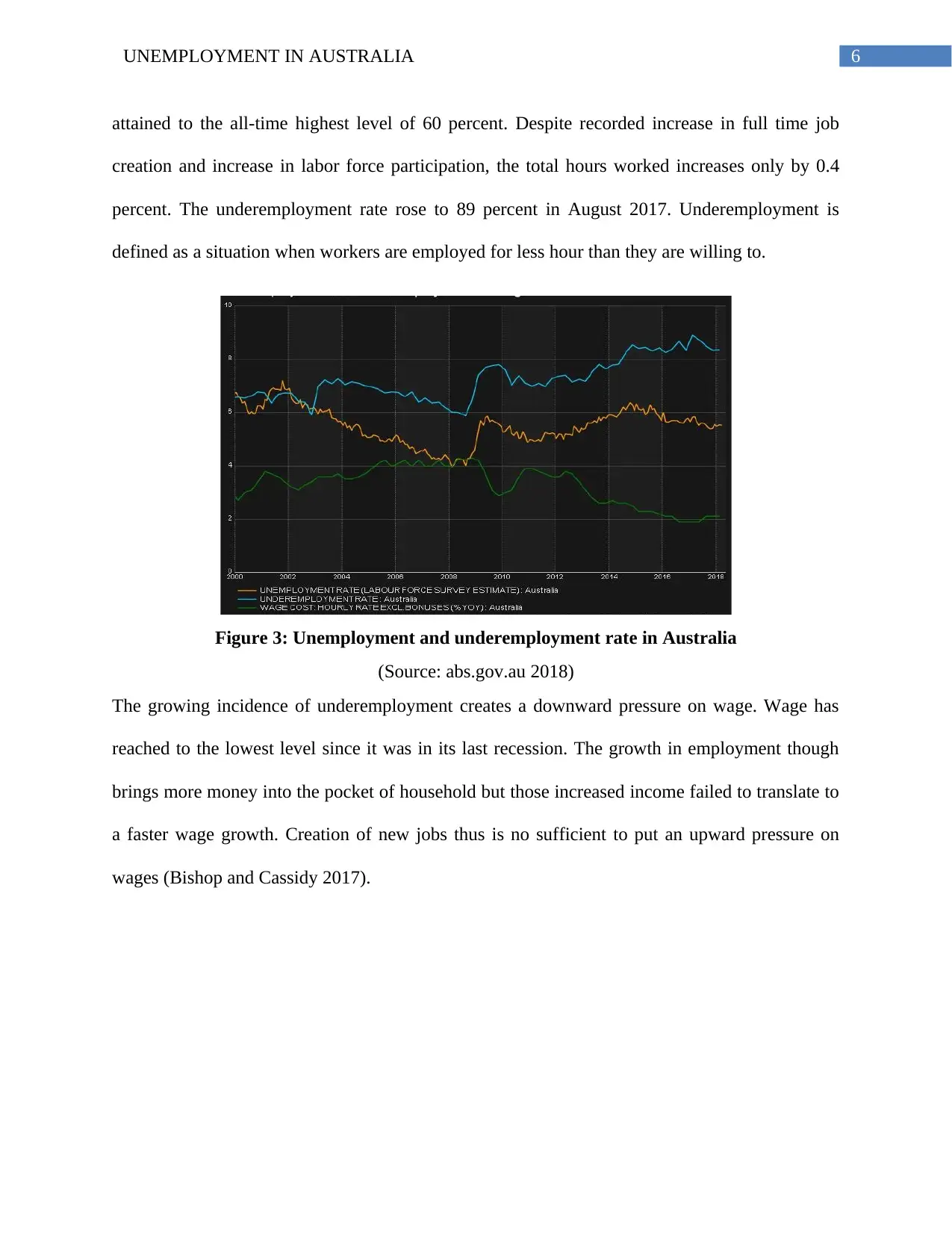
6UNEMPLOYMENT IN AUSTRALIA
attained to the all-time highest level of 60 percent. Despite recorded increase in full time job
creation and increase in labor force participation, the total hours worked increases only by 0.4
percent. The underemployment rate rose to 89 percent in August 2017. Underemployment is
defined as a situation when workers are employed for less hour than they are willing to.
Figure 3: Unemployment and underemployment rate in Australia
(Source: abs.gov.au 2018)
The growing incidence of underemployment creates a downward pressure on wage. Wage has
reached to the lowest level since it was in its last recession. The growth in employment though
brings more money into the pocket of household but those increased income failed to translate to
a faster wage growth. Creation of new jobs thus is no sufficient to put an upward pressure on
wages (Bishop and Cassidy 2017).
attained to the all-time highest level of 60 percent. Despite recorded increase in full time job
creation and increase in labor force participation, the total hours worked increases only by 0.4
percent. The underemployment rate rose to 89 percent in August 2017. Underemployment is
defined as a situation when workers are employed for less hour than they are willing to.
Figure 3: Unemployment and underemployment rate in Australia
(Source: abs.gov.au 2018)
The growing incidence of underemployment creates a downward pressure on wage. Wage has
reached to the lowest level since it was in its last recession. The growth in employment though
brings more money into the pocket of household but those increased income failed to translate to
a faster wage growth. Creation of new jobs thus is no sufficient to put an upward pressure on
wages (Bishop and Cassidy 2017).
Paraphrase This Document
Need a fresh take? Get an instant paraphrase of this document with our AI Paraphraser
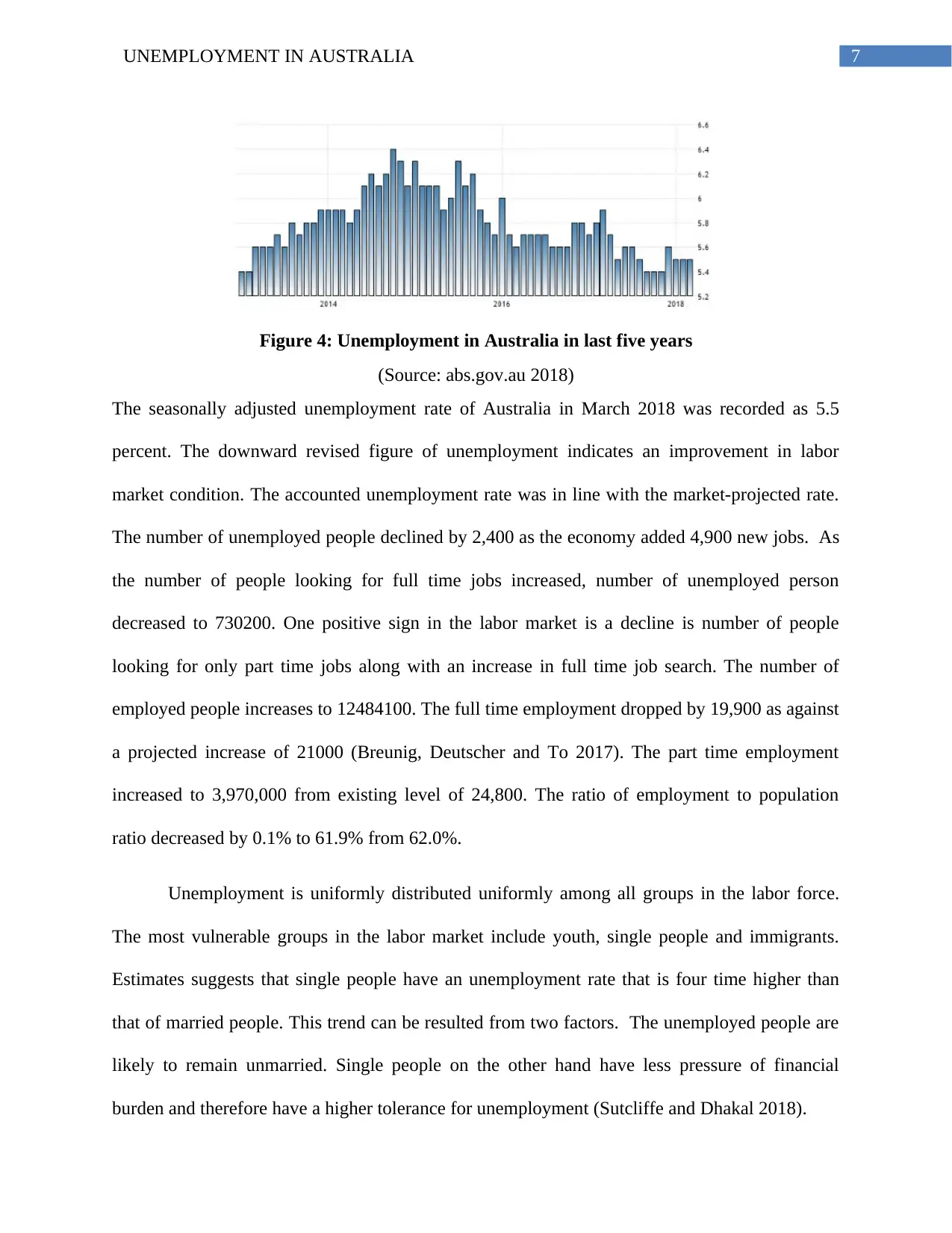
7UNEMPLOYMENT IN AUSTRALIA
Figure 4: Unemployment in Australia in last five years
(Source: abs.gov.au 2018)
The seasonally adjusted unemployment rate of Australia in March 2018 was recorded as 5.5
percent. The downward revised figure of unemployment indicates an improvement in labor
market condition. The accounted unemployment rate was in line with the market-projected rate.
The number of unemployed people declined by 2,400 as the economy added 4,900 new jobs. As
the number of people looking for full time jobs increased, number of unemployed person
decreased to 730200. One positive sign in the labor market is a decline is number of people
looking for only part time jobs along with an increase in full time job search. The number of
employed people increases to 12484100. The full time employment dropped by 19,900 as against
a projected increase of 21000 (Breunig, Deutscher and To 2017). The part time employment
increased to 3,970,000 from existing level of 24,800. The ratio of employment to population
ratio decreased by 0.1% to 61.9% from 62.0%.
Unemployment is uniformly distributed uniformly among all groups in the labor force.
The most vulnerable groups in the labor market include youth, single people and immigrants.
Estimates suggests that single people have an unemployment rate that is four time higher than
that of married people. This trend can be resulted from two factors. The unemployed people are
likely to remain unmarried. Single people on the other hand have less pressure of financial
burden and therefore have a higher tolerance for unemployment (Sutcliffe and Dhakal 2018).
Figure 4: Unemployment in Australia in last five years
(Source: abs.gov.au 2018)
The seasonally adjusted unemployment rate of Australia in March 2018 was recorded as 5.5
percent. The downward revised figure of unemployment indicates an improvement in labor
market condition. The accounted unemployment rate was in line with the market-projected rate.
The number of unemployed people declined by 2,400 as the economy added 4,900 new jobs. As
the number of people looking for full time jobs increased, number of unemployed person
decreased to 730200. One positive sign in the labor market is a decline is number of people
looking for only part time jobs along with an increase in full time job search. The number of
employed people increases to 12484100. The full time employment dropped by 19,900 as against
a projected increase of 21000 (Breunig, Deutscher and To 2017). The part time employment
increased to 3,970,000 from existing level of 24,800. The ratio of employment to population
ratio decreased by 0.1% to 61.9% from 62.0%.
Unemployment is uniformly distributed uniformly among all groups in the labor force.
The most vulnerable groups in the labor market include youth, single people and immigrants.
Estimates suggests that single people have an unemployment rate that is four time higher than
that of married people. This trend can be resulted from two factors. The unemployed people are
likely to remain unmarried. Single people on the other hand have less pressure of financial
burden and therefore have a higher tolerance for unemployment (Sutcliffe and Dhakal 2018).
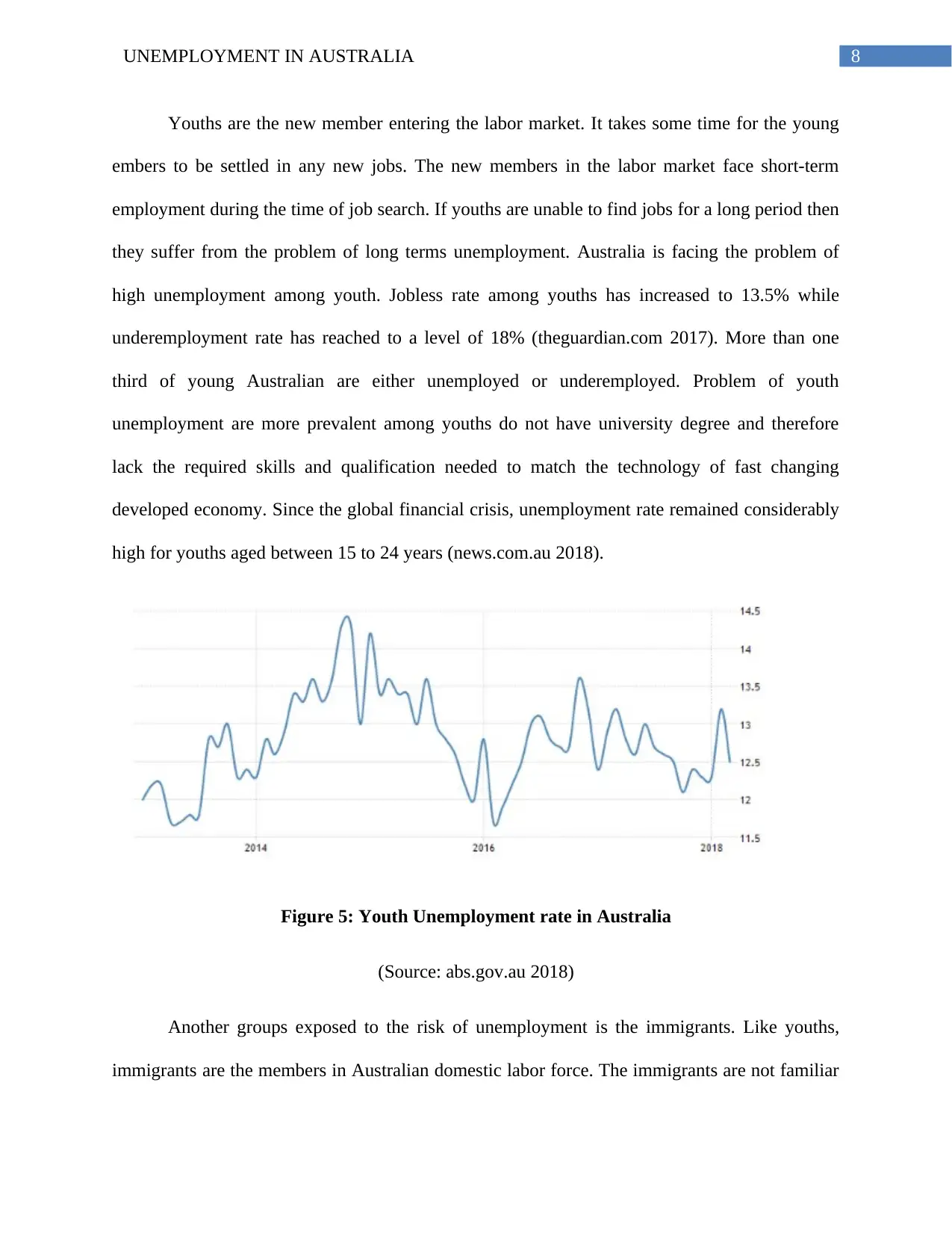
8UNEMPLOYMENT IN AUSTRALIA
Youths are the new member entering the labor market. It takes some time for the young
embers to be settled in any new jobs. The new members in the labor market face short-term
employment during the time of job search. If youths are unable to find jobs for a long period then
they suffer from the problem of long terms unemployment. Australia is facing the problem of
high unemployment among youth. Jobless rate among youths has increased to 13.5% while
underemployment rate has reached to a level of 18% (theguardian.com 2017). More than one
third of young Australian are either unemployed or underemployed. Problem of youth
unemployment are more prevalent among youths do not have university degree and therefore
lack the required skills and qualification needed to match the technology of fast changing
developed economy. Since the global financial crisis, unemployment rate remained considerably
high for youths aged between 15 to 24 years (news.com.au 2018).
Figure 5: Youth Unemployment rate in Australia
(Source: abs.gov.au 2018)
Another groups exposed to the risk of unemployment is the immigrants. Like youths,
immigrants are the members in Australian domestic labor force. The immigrants are not familiar
Youths are the new member entering the labor market. It takes some time for the young
embers to be settled in any new jobs. The new members in the labor market face short-term
employment during the time of job search. If youths are unable to find jobs for a long period then
they suffer from the problem of long terms unemployment. Australia is facing the problem of
high unemployment among youth. Jobless rate among youths has increased to 13.5% while
underemployment rate has reached to a level of 18% (theguardian.com 2017). More than one
third of young Australian are either unemployed or underemployed. Problem of youth
unemployment are more prevalent among youths do not have university degree and therefore
lack the required skills and qualification needed to match the technology of fast changing
developed economy. Since the global financial crisis, unemployment rate remained considerably
high for youths aged between 15 to 24 years (news.com.au 2018).
Figure 5: Youth Unemployment rate in Australia
(Source: abs.gov.au 2018)
Another groups exposed to the risk of unemployment is the immigrants. Like youths,
immigrants are the members in Australian domestic labor force. The immigrants are not familiar
⊘ This is a preview!⊘
Do you want full access?
Subscribe today to unlock all pages.

Trusted by 1+ million students worldwide
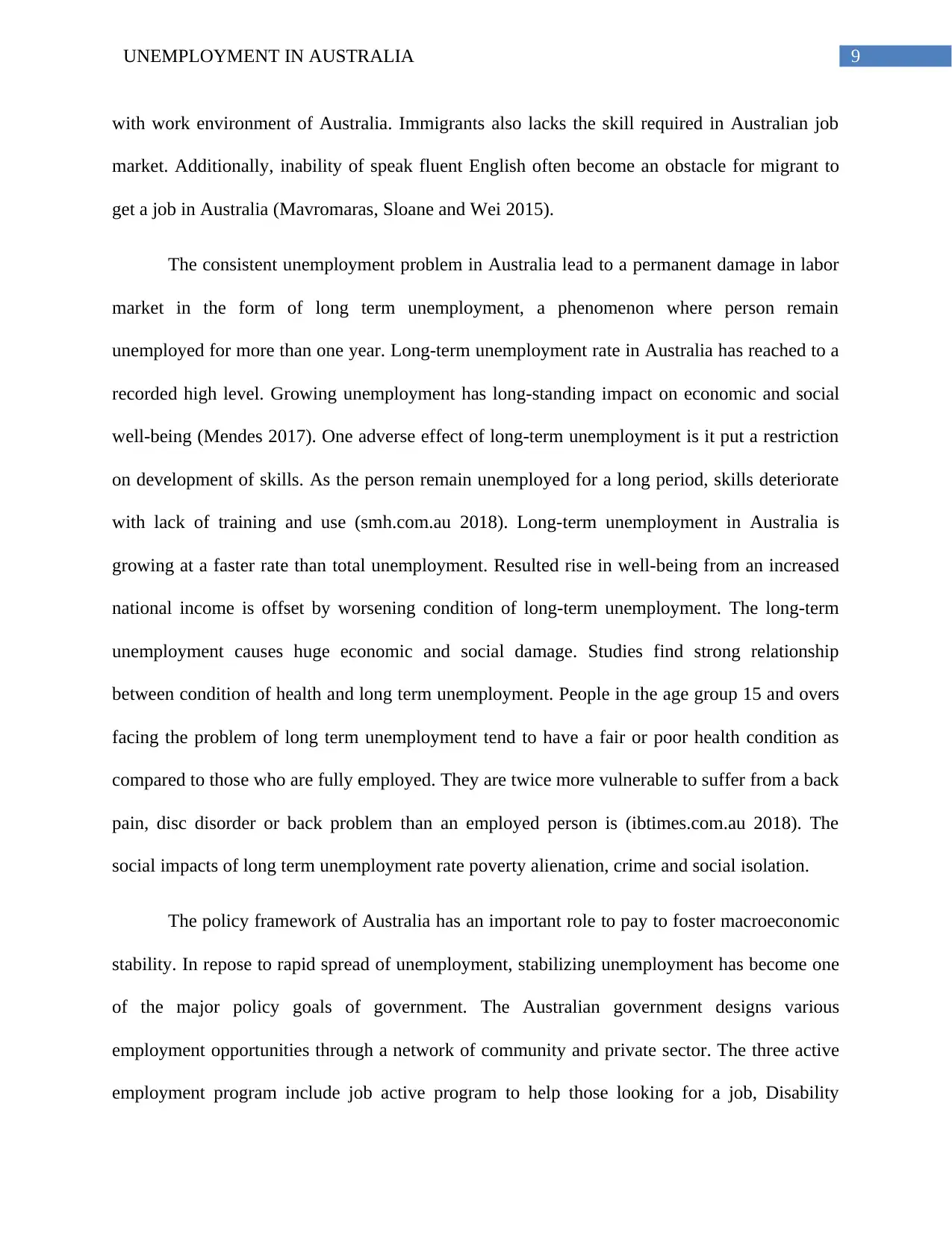
9UNEMPLOYMENT IN AUSTRALIA
with work environment of Australia. Immigrants also lacks the skill required in Australian job
market. Additionally, inability of speak fluent English often become an obstacle for migrant to
get a job in Australia (Mavromaras, Sloane and Wei 2015).
The consistent unemployment problem in Australia lead to a permanent damage in labor
market in the form of long term unemployment, a phenomenon where person remain
unemployed for more than one year. Long-term unemployment rate in Australia has reached to a
recorded high level. Growing unemployment has long-standing impact on economic and social
well-being (Mendes 2017). One adverse effect of long-term unemployment is it put a restriction
on development of skills. As the person remain unemployed for a long period, skills deteriorate
with lack of training and use (smh.com.au 2018). Long-term unemployment in Australia is
growing at a faster rate than total unemployment. Resulted rise in well-being from an increased
national income is offset by worsening condition of long-term unemployment. The long-term
unemployment causes huge economic and social damage. Studies find strong relationship
between condition of health and long term unemployment. People in the age group 15 and overs
facing the problem of long term unemployment tend to have a fair or poor health condition as
compared to those who are fully employed. They are twice more vulnerable to suffer from a back
pain, disc disorder or back problem than an employed person is (ibtimes.com.au 2018). The
social impacts of long term unemployment rate poverty alienation, crime and social isolation.
The policy framework of Australia has an important role to pay to foster macroeconomic
stability. In repose to rapid spread of unemployment, stabilizing unemployment has become one
of the major policy goals of government. The Australian government designs various
employment opportunities through a network of community and private sector. The three active
employment program include job active program to help those looking for a job, Disability
with work environment of Australia. Immigrants also lacks the skill required in Australian job
market. Additionally, inability of speak fluent English often become an obstacle for migrant to
get a job in Australia (Mavromaras, Sloane and Wei 2015).
The consistent unemployment problem in Australia lead to a permanent damage in labor
market in the form of long term unemployment, a phenomenon where person remain
unemployed for more than one year. Long-term unemployment rate in Australia has reached to a
recorded high level. Growing unemployment has long-standing impact on economic and social
well-being (Mendes 2017). One adverse effect of long-term unemployment is it put a restriction
on development of skills. As the person remain unemployed for a long period, skills deteriorate
with lack of training and use (smh.com.au 2018). Long-term unemployment in Australia is
growing at a faster rate than total unemployment. Resulted rise in well-being from an increased
national income is offset by worsening condition of long-term unemployment. The long-term
unemployment causes huge economic and social damage. Studies find strong relationship
between condition of health and long term unemployment. People in the age group 15 and overs
facing the problem of long term unemployment tend to have a fair or poor health condition as
compared to those who are fully employed. They are twice more vulnerable to suffer from a back
pain, disc disorder or back problem than an employed person is (ibtimes.com.au 2018). The
social impacts of long term unemployment rate poverty alienation, crime and social isolation.
The policy framework of Australia has an important role to pay to foster macroeconomic
stability. In repose to rapid spread of unemployment, stabilizing unemployment has become one
of the major policy goals of government. The Australian government designs various
employment opportunities through a network of community and private sector. The three active
employment program include job active program to help those looking for a job, Disability
Paraphrase This Document
Need a fresh take? Get an instant paraphrase of this document with our AI Paraphraser
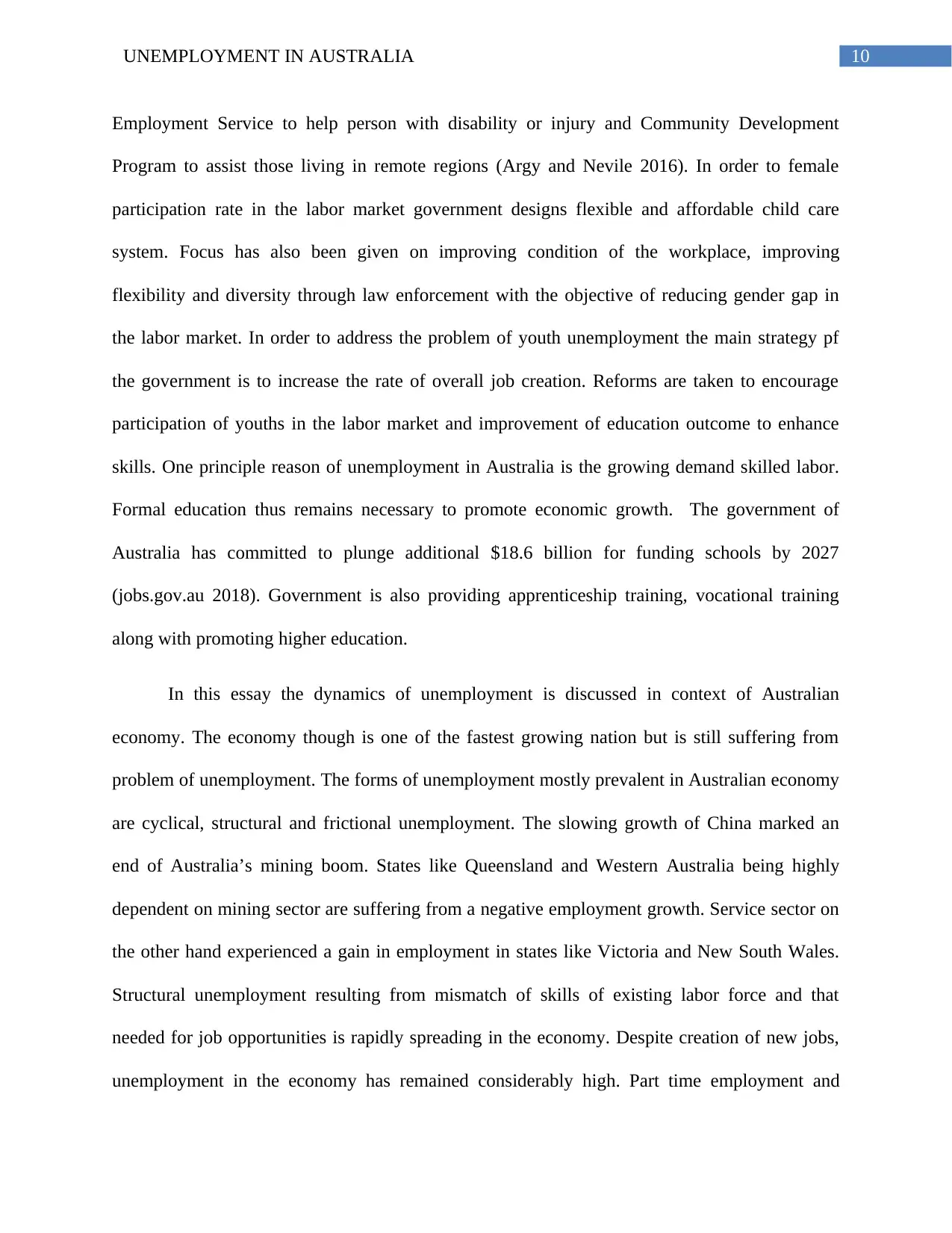
10UNEMPLOYMENT IN AUSTRALIA
Employment Service to help person with disability or injury and Community Development
Program to assist those living in remote regions (Argy and Nevile 2016). In order to female
participation rate in the labor market government designs flexible and affordable child care
system. Focus has also been given on improving condition of the workplace, improving
flexibility and diversity through law enforcement with the objective of reducing gender gap in
the labor market. In order to address the problem of youth unemployment the main strategy pf
the government is to increase the rate of overall job creation. Reforms are taken to encourage
participation of youths in the labor market and improvement of education outcome to enhance
skills. One principle reason of unemployment in Australia is the growing demand skilled labor.
Formal education thus remains necessary to promote economic growth. The government of
Australia has committed to plunge additional $18.6 billion for funding schools by 2027
(jobs.gov.au 2018). Government is also providing apprenticeship training, vocational training
along with promoting higher education.
In this essay the dynamics of unemployment is discussed in context of Australian
economy. The economy though is one of the fastest growing nation but is still suffering from
problem of unemployment. The forms of unemployment mostly prevalent in Australian economy
are cyclical, structural and frictional unemployment. The slowing growth of China marked an
end of Australia’s mining boom. States like Queensland and Western Australia being highly
dependent on mining sector are suffering from a negative employment growth. Service sector on
the other hand experienced a gain in employment in states like Victoria and New South Wales.
Structural unemployment resulting from mismatch of skills of existing labor force and that
needed for job opportunities is rapidly spreading in the economy. Despite creation of new jobs,
unemployment in the economy has remained considerably high. Part time employment and
Employment Service to help person with disability or injury and Community Development
Program to assist those living in remote regions (Argy and Nevile 2016). In order to female
participation rate in the labor market government designs flexible and affordable child care
system. Focus has also been given on improving condition of the workplace, improving
flexibility and diversity through law enforcement with the objective of reducing gender gap in
the labor market. In order to address the problem of youth unemployment the main strategy pf
the government is to increase the rate of overall job creation. Reforms are taken to encourage
participation of youths in the labor market and improvement of education outcome to enhance
skills. One principle reason of unemployment in Australia is the growing demand skilled labor.
Formal education thus remains necessary to promote economic growth. The government of
Australia has committed to plunge additional $18.6 billion for funding schools by 2027
(jobs.gov.au 2018). Government is also providing apprenticeship training, vocational training
along with promoting higher education.
In this essay the dynamics of unemployment is discussed in context of Australian
economy. The economy though is one of the fastest growing nation but is still suffering from
problem of unemployment. The forms of unemployment mostly prevalent in Australian economy
are cyclical, structural and frictional unemployment. The slowing growth of China marked an
end of Australia’s mining boom. States like Queensland and Western Australia being highly
dependent on mining sector are suffering from a negative employment growth. Service sector on
the other hand experienced a gain in employment in states like Victoria and New South Wales.
Structural unemployment resulting from mismatch of skills of existing labor force and that
needed for job opportunities is rapidly spreading in the economy. Despite creation of new jobs,
unemployment in the economy has remained considerably high. Part time employment and
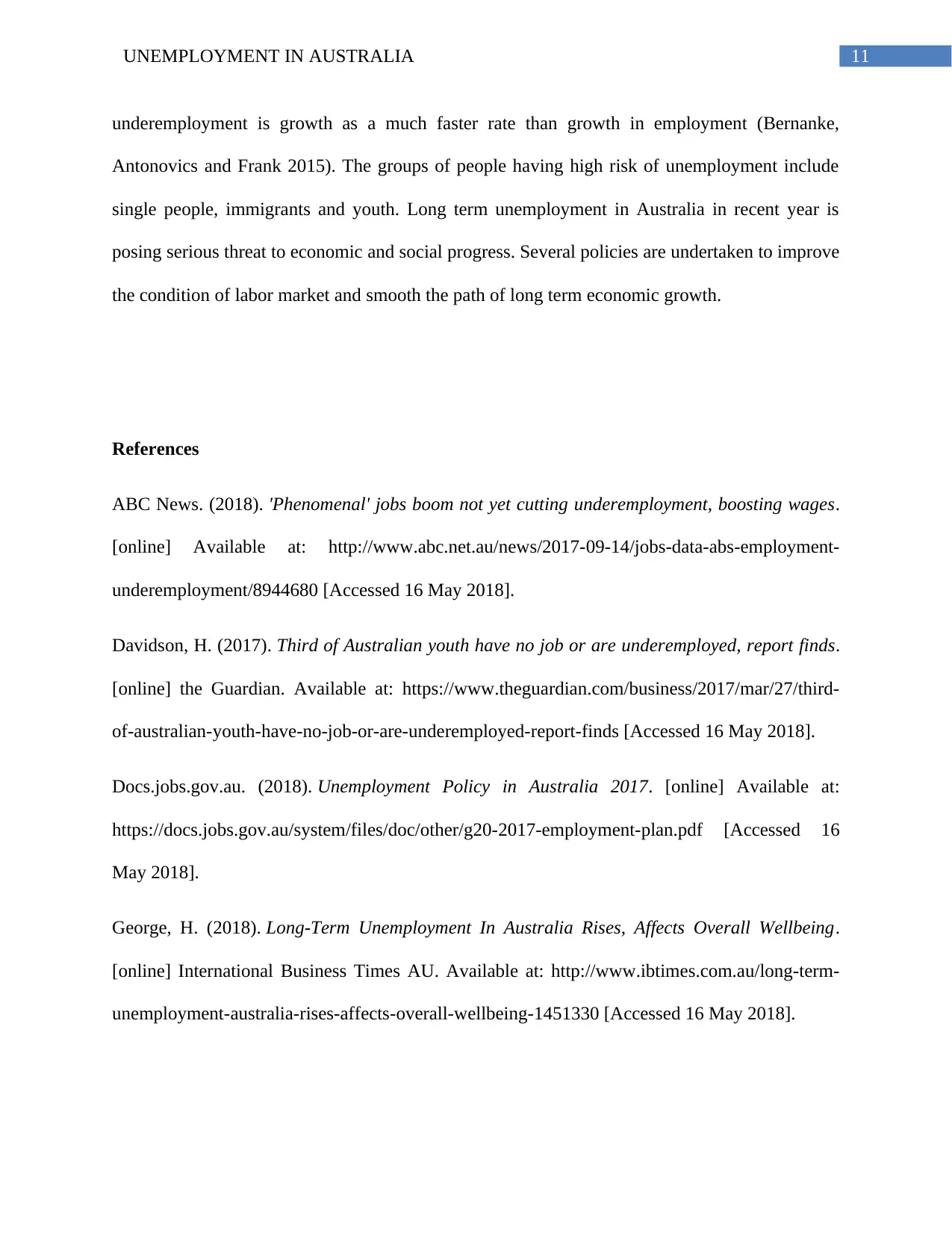
11UNEMPLOYMENT IN AUSTRALIA
underemployment is growth as a much faster rate than growth in employment (Bernanke,
Antonovics and Frank 2015). The groups of people having high risk of unemployment include
single people, immigrants and youth. Long term unemployment in Australia in recent year is
posing serious threat to economic and social progress. Several policies are undertaken to improve
the condition of labor market and smooth the path of long term economic growth.
References
ABC News. (2018). 'Phenomenal' jobs boom not yet cutting underemployment, boosting wages.
[online] Available at: http://www.abc.net.au/news/2017-09-14/jobs-data-abs-employment-
underemployment/8944680 [Accessed 16 May 2018].
Davidson, H. (2017). Third of Australian youth have no job or are underemployed, report finds.
[online] the Guardian. Available at: https://www.theguardian.com/business/2017/mar/27/third-
of-australian-youth-have-no-job-or-are-underemployed-report-finds [Accessed 16 May 2018].
Docs.jobs.gov.au. (2018). Unemployment Policy in Australia 2017. [online] Available at:
https://docs.jobs.gov.au/system/files/doc/other/g20-2017-employment-plan.pdf [Accessed 16
May 2018].
George, H. (2018). Long-Term Unemployment In Australia Rises, Affects Overall Wellbeing.
[online] International Business Times AU. Available at: http://www.ibtimes.com.au/long-term-
unemployment-australia-rises-affects-overall-wellbeing-1451330 [Accessed 16 May 2018].
underemployment is growth as a much faster rate than growth in employment (Bernanke,
Antonovics and Frank 2015). The groups of people having high risk of unemployment include
single people, immigrants and youth. Long term unemployment in Australia in recent year is
posing serious threat to economic and social progress. Several policies are undertaken to improve
the condition of labor market and smooth the path of long term economic growth.
References
ABC News. (2018). 'Phenomenal' jobs boom not yet cutting underemployment, boosting wages.
[online] Available at: http://www.abc.net.au/news/2017-09-14/jobs-data-abs-employment-
underemployment/8944680 [Accessed 16 May 2018].
Davidson, H. (2017). Third of Australian youth have no job or are underemployed, report finds.
[online] the Guardian. Available at: https://www.theguardian.com/business/2017/mar/27/third-
of-australian-youth-have-no-job-or-are-underemployed-report-finds [Accessed 16 May 2018].
Docs.jobs.gov.au. (2018). Unemployment Policy in Australia 2017. [online] Available at:
https://docs.jobs.gov.au/system/files/doc/other/g20-2017-employment-plan.pdf [Accessed 16
May 2018].
George, H. (2018). Long-Term Unemployment In Australia Rises, Affects Overall Wellbeing.
[online] International Business Times AU. Available at: http://www.ibtimes.com.au/long-term-
unemployment-australia-rises-affects-overall-wellbeing-1451330 [Accessed 16 May 2018].
⊘ This is a preview!⊘
Do you want full access?
Subscribe today to unlock all pages.

Trusted by 1+ million students worldwide
1 out of 15
Related Documents
Your All-in-One AI-Powered Toolkit for Academic Success.
+13062052269
info@desklib.com
Available 24*7 on WhatsApp / Email
![[object Object]](/_next/static/media/star-bottom.7253800d.svg)
Unlock your academic potential
Copyright © 2020–2025 A2Z Services. All Rights Reserved. Developed and managed by ZUCOL.



